2004 CHEVROLET EXPRESS CARGO VAN child restraint
[x] Cancel search: child restraintPage 1 of 406
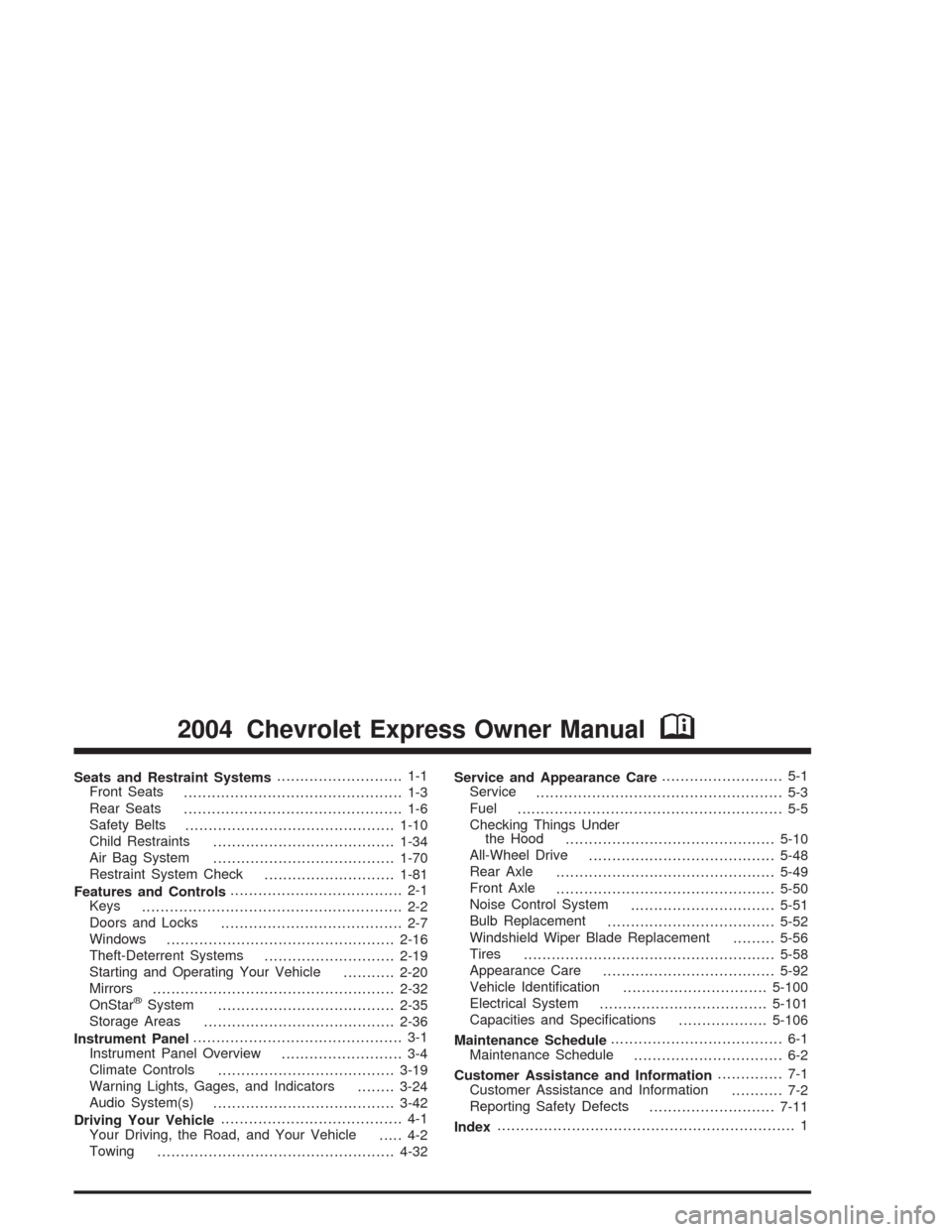
Seats and Restraint Systems........................... 1-1
Front Seats
............................................... 1-3
Rear Seats
............................................... 1-6
Safety Belts
.............................................1-10
Child Restraints
.......................................1-34
Air Bag System
.......................................1-70
Restraint System Check
............................1-81
Features and Controls..................................... 2-1
Keys
........................................................ 2-2
Doors and Locks
....................................... 2-7
Windows
.................................................2-16
Theft-Deterrent Systems
............................2-19
Starting and Operating Your Vehicle
...........2-20
Mirrors
....................................................2-32
OnStar
®System
......................................2-35
Storage Areas
.........................................2-36
Instrument Panel............................................. 3-1
Instrument Panel Overview
.......................... 3-4
Climate Controls
......................................3-19
Warning Lights, Gages, and Indicators
........3-24
Audio System(s)
.......................................3-42
Driving Your Vehicle....................................... 4-1
Your Driving, the Road, and Your Vehicle
..... 4-2
Towing
...................................................4-32Service and Appearance Care.......................... 5-1
Service
..................................................... 5-3
Fuel
......................................................... 5-5
Checking Things Under
the Hood
.............................................5-10
All-Wheel Drive
........................................5-48
Rear Axle
...............................................5-49
Front Axle
...............................................5-50
Noise Control System
...............................5-51
Bulb Replacement
....................................5-52
Windshield Wiper Blade Replacement
.........5-56
Tires
......................................................5-58
Appearance Care
.....................................5-92
Vehicle Identi�cation
...............................5-100
Electrical System
....................................5-101
Capacities and Speci�cations
...................5-106
Maintenance Schedule..................................... 6-1
Maintenance Schedule
................................ 6-2
Customer Assistance and Information.............. 7-1
Customer Assistance and Information
........... 7-2
Reporting Safety Defects
...........................7-11
Index................................................................ 1
2004 Chevrolet Express Owner ManualM
Page 7 of 406
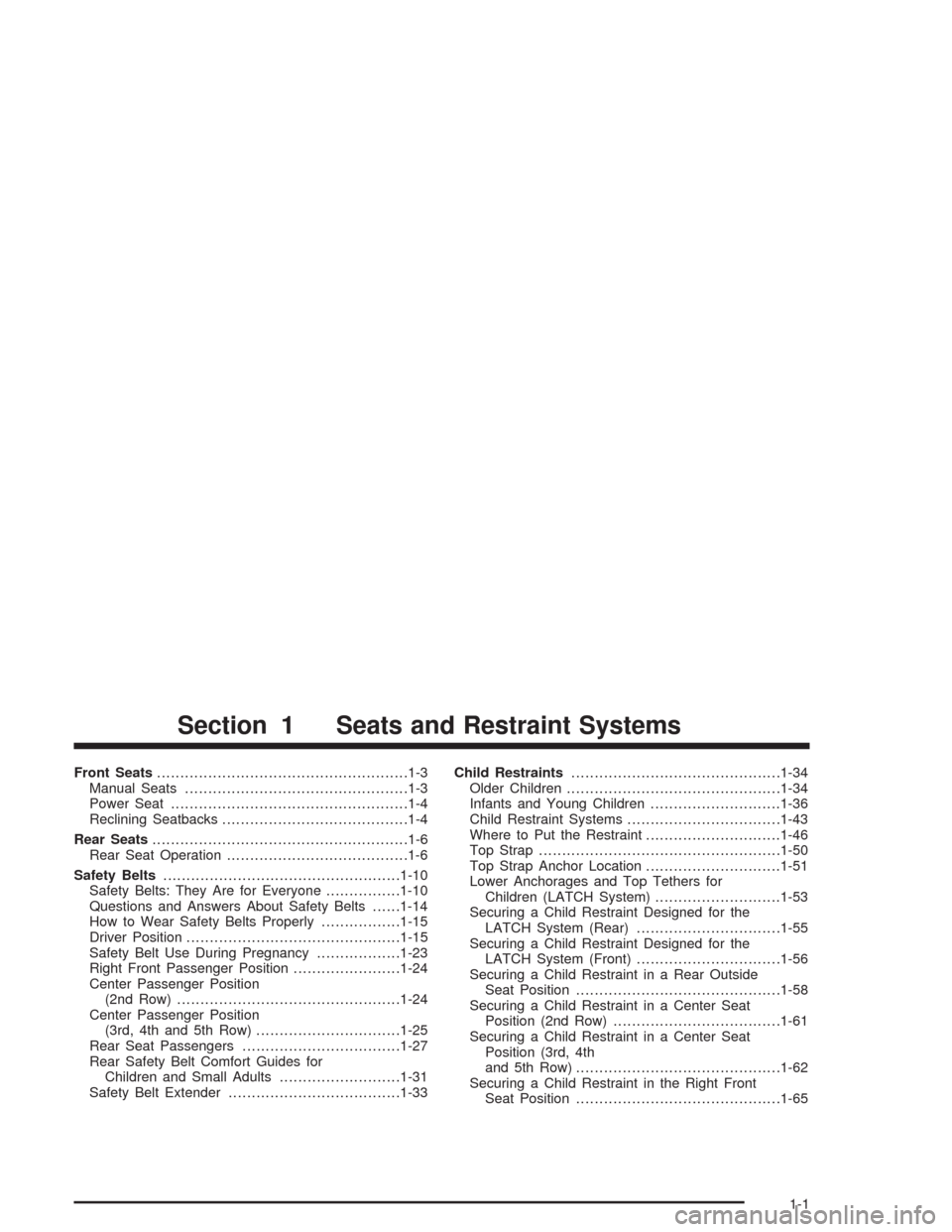
Front Seats......................................................1-3
Manual Seats................................................1-3
Power Seat...................................................1-4
Reclining Seatbacks........................................1-4
Rear Seats.......................................................1-6
Rear Seat Operation.......................................1-6
Safety Belts...................................................1-10
Safety Belts: They Are for Everyone................1-10
Questions and Answers About Safety Belts......1-14
How to Wear Safety Belts Properly.................1-15
Driver Position..............................................1-15
Safety Belt Use During Pregnancy..................1-23
Right Front Passenger Position.......................1-24
Center Passenger Position
(2nd Row)................................................1-24
Center Passenger Position
(3rd, 4th and 5th Row)...............................1-25
Rear Seat Passengers..................................1-27
Rear Safety Belt Comfort Guides for
Children and Small Adults..........................1-31
Safety Belt Extender.....................................1-33Child Restraints.............................................1-34
Older Children..............................................1-34
Infants and Young Children............................1-36
Child Restraint Systems.................................1-43
Where to Put the Restraint.............................1-46
Top Strap....................................................1-50
Top Strap Anchor Location.............................1-51
Lower Anchorages and Top Tethers for
Children (LATCH System)...........................1-53
Securing a Child Restraint Designed for the
LATCH System (Rear)...............................1-55
Securing a Child Restraint Designed for the
LATCH System (Front)...............................1-56
Securing a Child Restraint in a Rear Outside
Seat Position............................................1-58
Securing a Child Restraint in a Center Seat
Position (2nd Row)....................................1-61
Securing a Child Restraint in a Center Seat
Position (3rd, 4th
and 5th Row)............................................1-62
Securing a Child Restraint in the Right Front
Seat Position............................................1-65
Section 1 Seats and Restraint Systems
1-1
Page 21 of 406
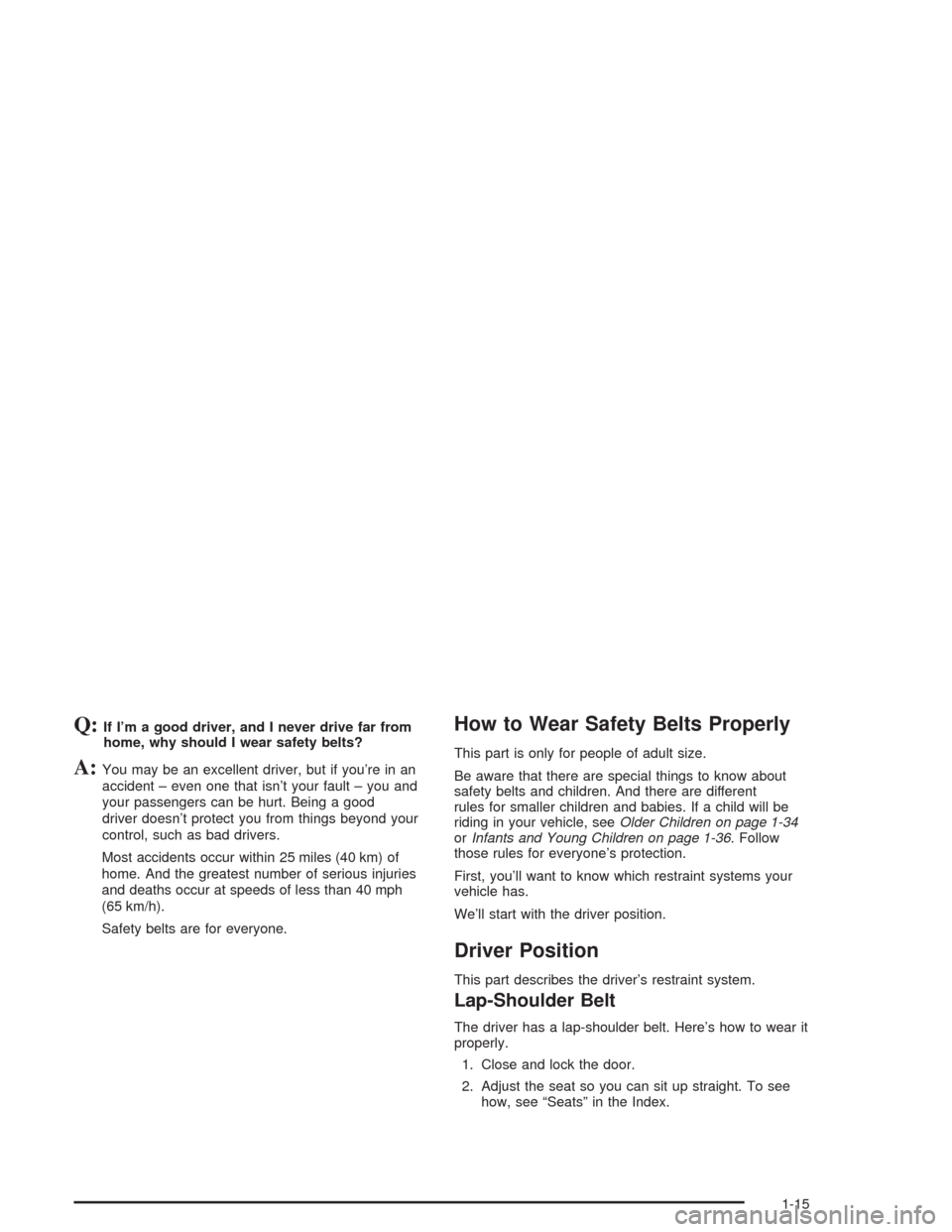
Q:If I’m a good driver, and I never drive far from
home, why should I wear safety belts?
A:You may be an excellent driver, but if you’re in an
accident – even one that isn’t your fault – you and
your passengers can be hurt. Being a good
driver doesn’t protect you from things beyond your
control, such as bad drivers.
Most accidents occur within 25 miles (40 km) of
home. And the greatest number of serious injuries
and deaths occur at speeds of less than 40 mph
(65 km/h).
Safety belts are for everyone.
How to Wear Safety Belts Properly
This part is only for people of adult size.
Be aware that there are special things to know about
safety belts and children. And there are different
rules for smaller children and babies. If a child will be
riding in your vehicle, seeOlder Children on page 1-34
orInfants and Young Children on page 1-36. Follow
those rules for everyone’s protection.
First, you’ll want to know which restraint systems your
vehicle has.
We’ll start with the driver position.
Driver Position
This part describes the driver’s restraint system.
Lap-Shoulder Belt
The driver has a lap-shoulder belt. Here’s how to wear it
properly.
1. Close and lock the door.
2. Adjust the seat so you can sit up straight. To see
how, see “Seats” in the Index.
1-15
Page 30 of 406
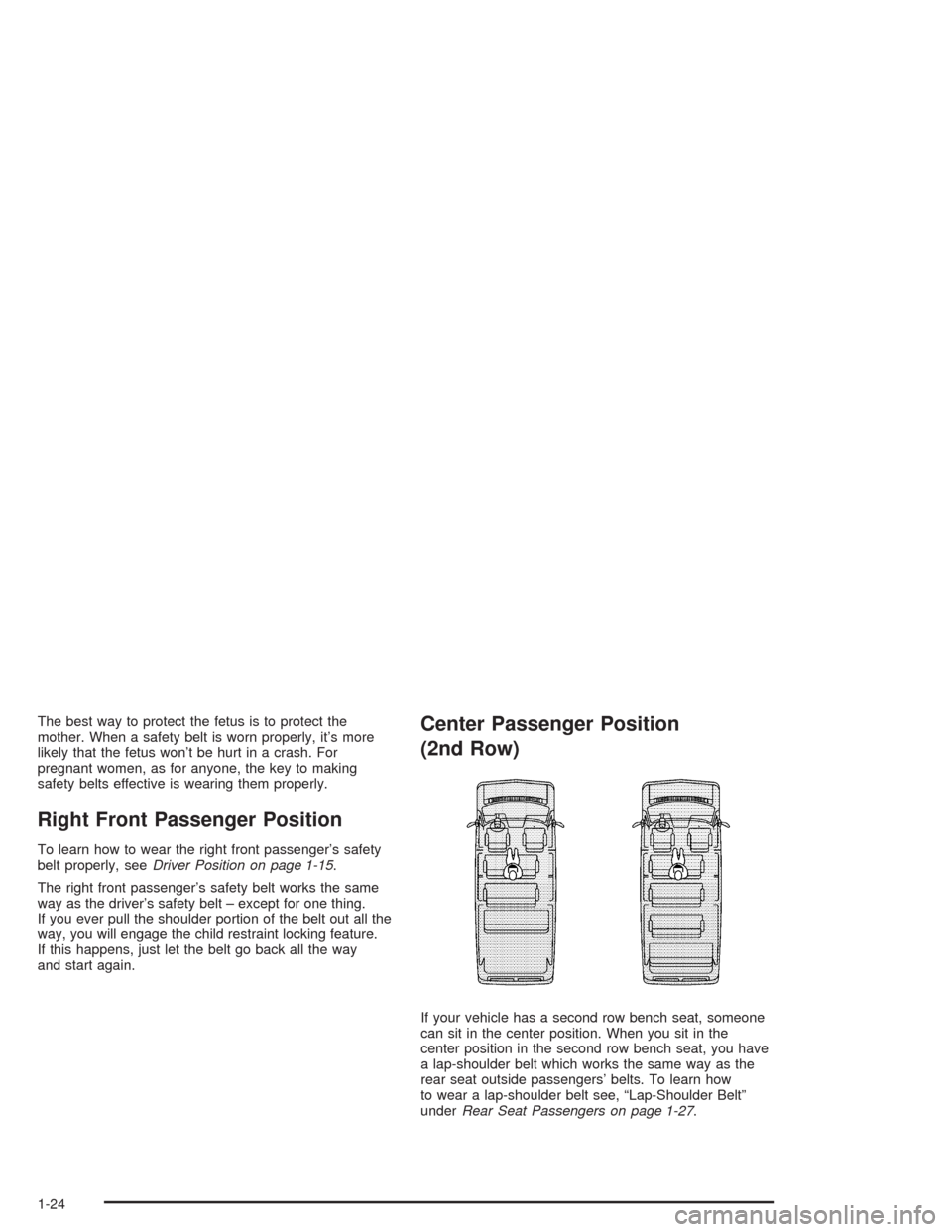
The best way to protect the fetus is to protect the
mother. When a safety belt is worn properly, it’s more
likely that the fetus won’t be hurt in a crash. For
pregnant women, as for anyone, the key to making
safety belts effective is wearing them properly.
Right Front Passenger Position
To learn how to wear the right front passenger’s safety
belt properly, seeDriver Position on page 1-15.
The right front passenger’s safety belt works the same
way as the driver’s safety belt – except for one thing.
If you ever pull the shoulder portion of the belt out all the
way, you will engage the child restraint locking feature.
If this happens, just let the belt go back all the way
and start again.
Center Passenger Position
(2nd Row)
If your vehicle has a second row bench seat, someone
can sit in the center position. When you sit in the
center position in the second row bench seat, you have
a lap-shoulder belt which works the same way as the
rear seat outside passengers’ belts. To learn how
to wear a lap-shoulder belt see, “Lap-Shoulder Belt”
underRear Seat Passengers on page 1-27.
1-24
Page 34 of 406
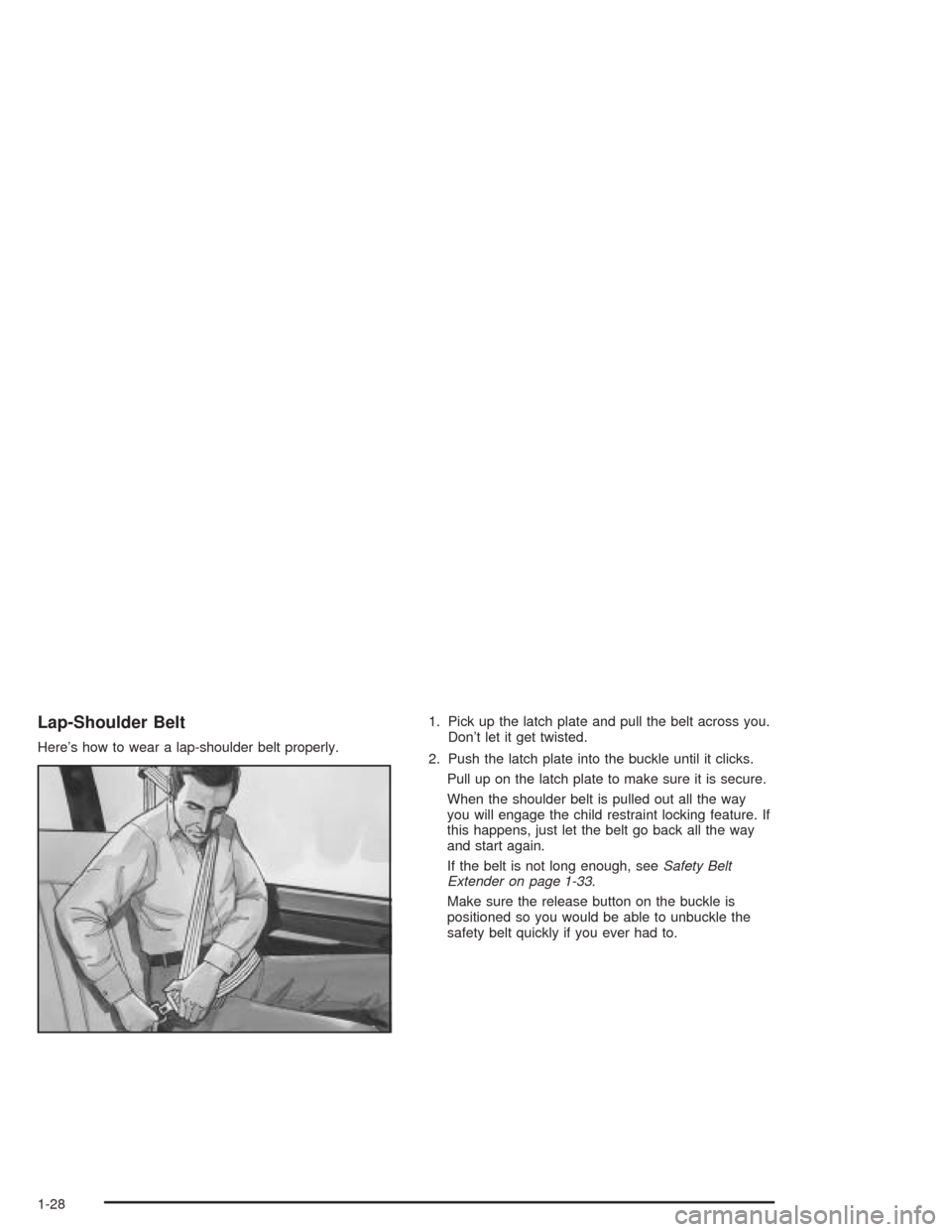
Lap-Shoulder Belt
Here’s how to wear a lap-shoulder belt properly.1. Pick up the latch plate and pull the belt across you.
Don’t let it get twisted.
2. Push the latch plate into the buckle until it clicks.
Pull up on the latch plate to make sure it is secure.
When the shoulder belt is pulled out all the way
you will engage the child restraint locking feature. If
this happens, just let the belt go back all the way
and start again.
If the belt is not long enough, seeSafety Belt
Extender on page 1-33.
Make sure the release button on the buckle is
positioned so you would be able to unbuckle the
safety belt quickly if you ever had to.
1-28
Page 37 of 406
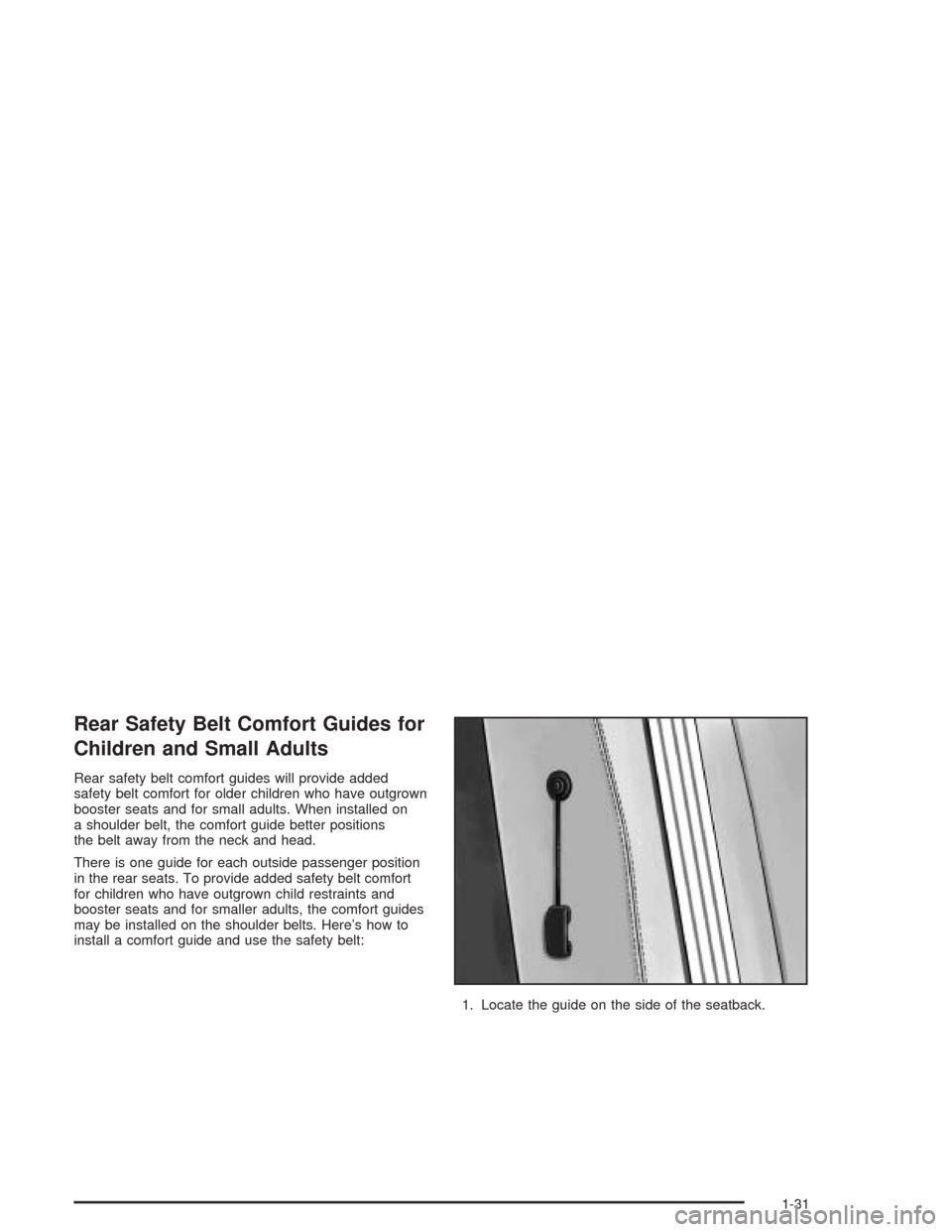
Rear Safety Belt Comfort Guides for
Children and Small Adults
Rear safety belt comfort guides will provide added
safety belt comfort for older children who have outgrown
booster seats and for small adults. When installed on
a shoulder belt, the comfort guide better positions
the belt away from the neck and head.
There is one guide for each outside passenger position
in the rear seats. To provide added safety belt comfort
for children who have outgrown child restraints and
booster seats and for smaller adults, the comfort guides
may be installed on the shoulder belts. Here’s how to
install a comfort guide and use the safety belt:
1. Locate the guide on the side of the seatback.
1-31
Page 40 of 406
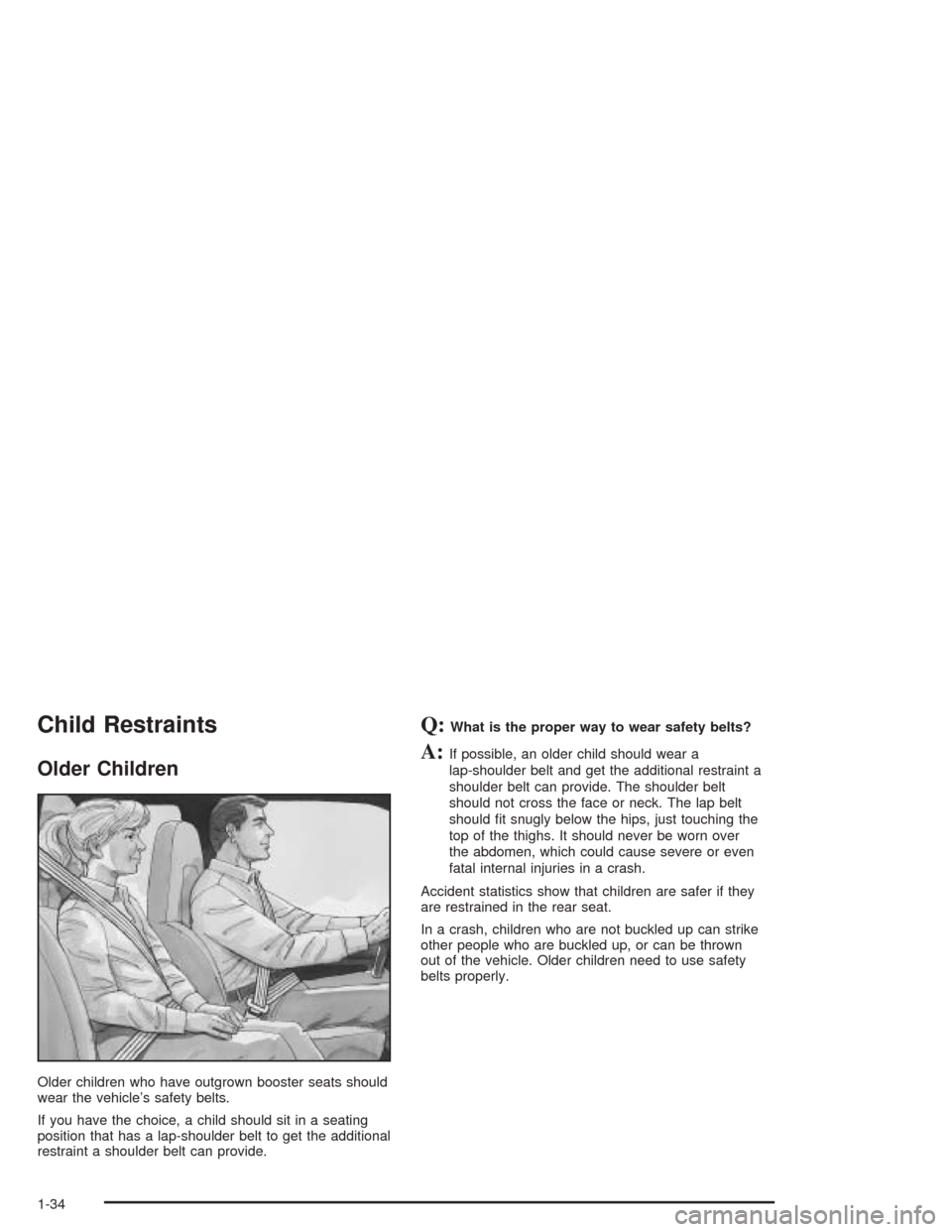
Child Restraints
Older Children
Older children who have outgrown booster seats should
wear the vehicle’s safety belts.
If you have the choice, a child should sit in a seating
position that has a lap-shoulder belt to get the additional
restraint a shoulder belt can provide.
Q:What is the proper way to wear safety belts?
A:If possible, an older child should wear a
lap-shoulder belt and get the additional restraint a
shoulder belt can provide. The shoulder belt
should not cross the face or neck. The lap belt
should �t snugly below the hips, just touching the
top of the thighs. It should never be worn over
the abdomen, which could cause severe or even
fatal internal injuries in a crash.
Accident statistics show that children are safer if they
are restrained in the rear seat.
In a crash, children who are not buckled up can strike
other people who are buckled up, or can be thrown
out of the vehicle. Older children need to use safety
belts properly.
1-34
Page 41 of 406
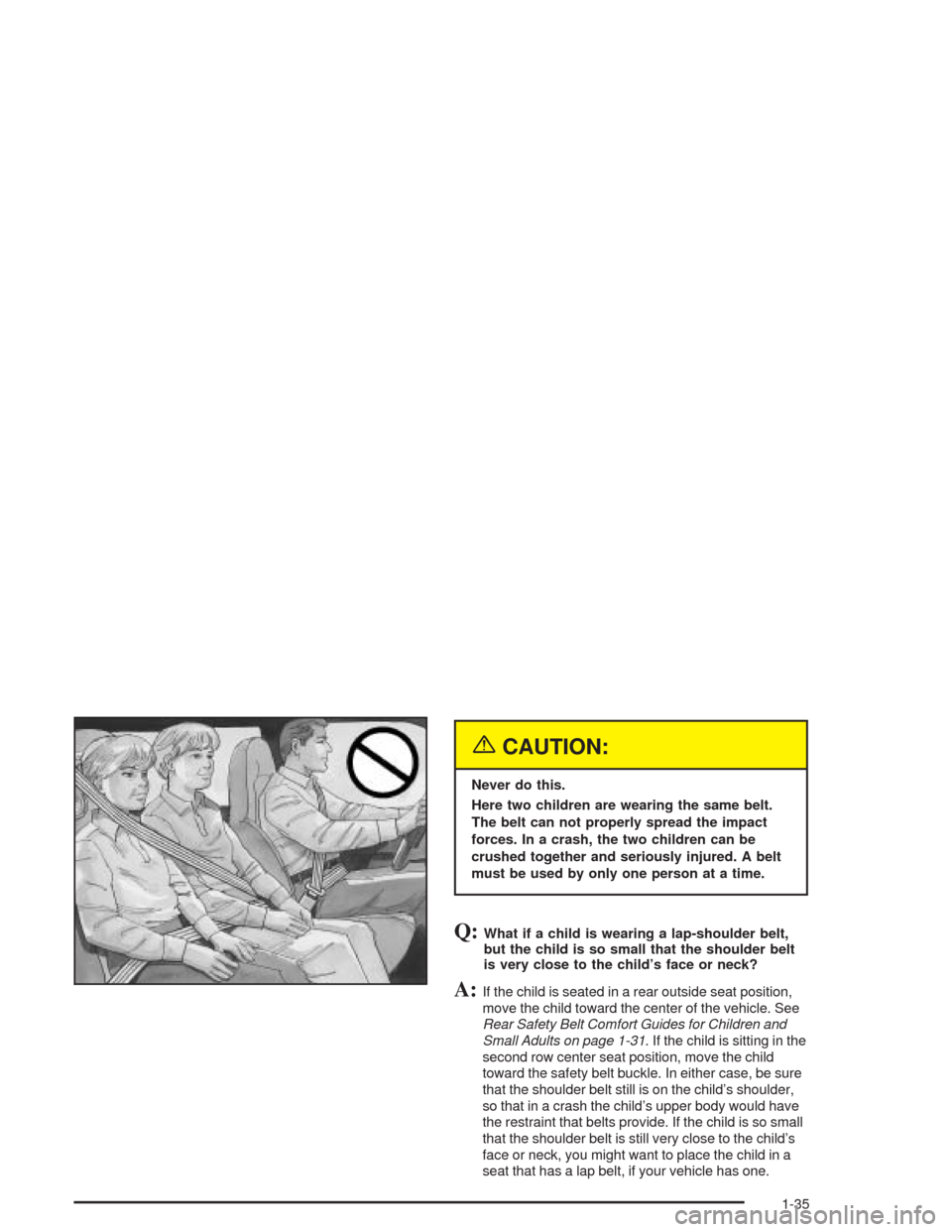
{CAUTION:
Never do this.
Here two children are wearing the same belt.
The belt can not properly spread the impact
forces. In a crash, the two children can be
crushed together and seriously injured. A belt
must be used by only one person at a time.
Q:What if a child is wearing a lap-shoulder belt,
but the child is so small that the shoulder belt
is very close to the child’s face or neck?
A:If the child is seated in a rear outside seat position,
move the child toward the center of the vehicle. See
Rear Safety Belt Comfort Guides for Children and
Small Adults on page 1-31. If the child is sitting in the
second row center seat position, move the child
toward the safety belt buckle. In either case, be sure
that the shoulder belt still is on the child’s shoulder,
so that in a crash the child’s upper body would have
the restraint that belts provide. If the child is so small
that the shoulder belt is still very close to the child’s
face or neck, you might want to place the child in a
seat that has a lap belt, if your vehicle has one.
1-35